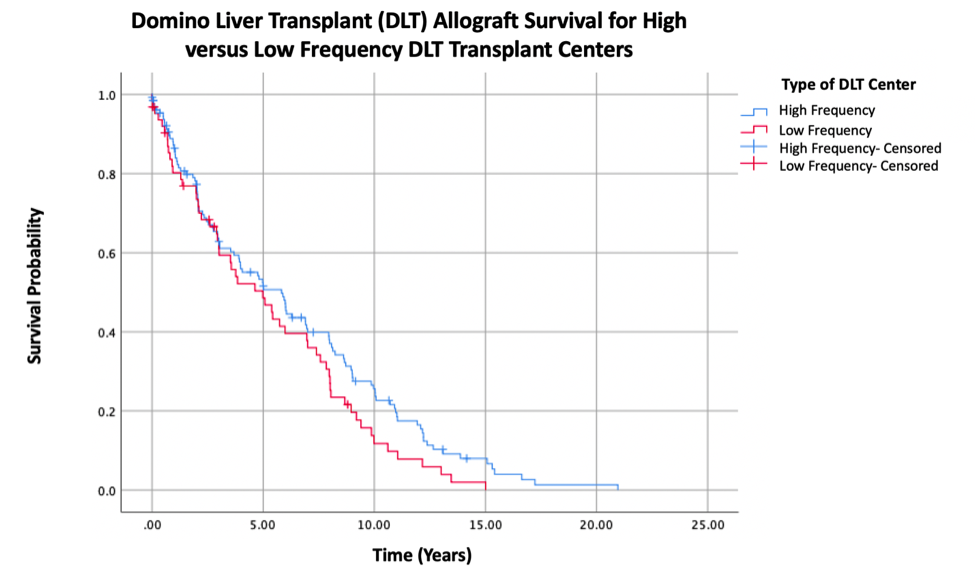High and Low Frequency Domino Liver Transplantation Centers Demonstrate Similar Outcomes
Temple University School of Medicine, Philadelphia, PA
Meeting: 2021 American Transplant Congress
Abstract number: 340
Keywords: Donation, Liver transplantation, Living donor
Topic: Clinical Science » Liver » Liver: Retransplantation and Other Complications
Session Information
Session Name: Post Liver Transplant Management and Complications
Session Type: Rapid Fire Oral Abstract
Date: Tuesday, June 8, 2021
Session Time: 4:30pm-5:30pm
 Presentation Time: 5:00pm-5:05pm
Presentation Time: 5:00pm-5:05pm
Location: Virtual
*Purpose: For patients with transthyretin (TTR) Amyloidosis, the only disease modifying treatment is an orthotopic liver transplant. However, because of the nature of this disease, the patient’s liver can simultaneously be donated to another patient. Current research already demonstrates the success of Domino Liver Transplants (DLTs) and points to the benefit of this procedure in increasing the donor organ pool for those in dire need of a transplant. However, the use of DLTs in many transplant centers has been limited. Trepidation over outcomes and complications in low frequency DLT centers has deterred hospitals from performing this procedure. This study analyzes the performance outcomes (of the DLT recipient) of transplant centers that perform a high number of DLTs to those that perform less DLTs.
*Methods: United Network for Organ Sharing (UNOS)/Organ Procurement and Transplantation (OPTN) Standard Transplant Analysis and Research (STAR) database was queried and analyzed with SPSS version 26 IBM. Whole liver domino patients were extracted from the living donor dataset for transplants performed between April of 1996 and January of 2018 (n=193). Quantitative data was recorded as a mean with a standard deviation, while qualitative data is recorded as a frequency and percentage of the population queried. A Kaplan-Meier curve was also performed. High frequency DLT centers were defined as those who have performed more than 5 DLTs — above the 75th percentile for DLTs performed in transplant centers nationally.
*Results: Overall outcomes between low and high frequency DLT centers were very similar. There was no difference between types of centers in cardiac, respiratory, or renal failure as a cause of death. There was no difference in functional status at the last follow-up between the two types of centers. The Kaplan-Meier curve shows the allograft survival is similar between the two groups. Graft status at the time of the last follow-up showed 91.7% of grafts functioning in the low frequency centers compared to 86.5% of grafts functioning high frequency centers. Acute rejection (1.5% high frequency versus 1.6% low frequency) and chronic rejection (1.5% high frequency versus 1.6% low frequency) were shown to be a similarly low value between the groups.
*Conclusions: The outcomes of low frequency DLT centers are very similar— if not better— than those of the high frequency DLT centers. This encourages hesitant transplant centers to perform more DLTs without the fear of outcomes or complications. Continued analysis to show significance are underway.
To cite this abstract in AMA style:
Panichella J, Resweber H, Curtis H, Nguyen K, Carlo ADi, Karhadkar S. High and Low Frequency Domino Liver Transplantation Centers Demonstrate Similar Outcomes [abstract]. Am J Transplant. 2021; 21 (suppl 3). https://atcmeetingabstracts.com/abstract/high-and-low-frequency-domino-liver-transplantation-centers-demonstrate-similar-outcomes/. Accessed January 7, 2026.« Back to 2021 American Transplant Congress

